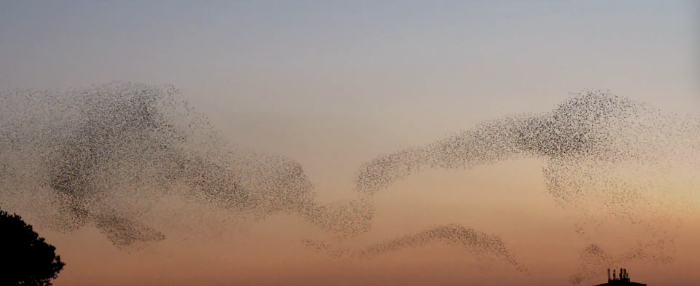For those in love with murmuration...
 Colossal says: "Filmmaker Neels Castillon was on a commercial shoot a few days ago, waiting to catch a helicopter flying into a sunset, when suddenly tens of thousands of starlings unexpectedly swarmed the sky in an enormous dance known as a murmuration. With his director of photography, Mathias Touzeris, the two filmed for several minutes capturing some pretty magnificent footage. You might recall a similar murmuration video from last year shot extremely up close and personal using a camera phone that went viral. How do thousands of birds simultaneously make such dramatic changes in their flight patterns? After tons of research, scientists still aren’t sure. The music is Hand-Made by Alt-J." [vimeo http://vimeo.com/58291553 w=700&h=400] Until recently, it was hard to say what made the murmurations possible. Scientists had to wait for the tools of high-powered video analysis and computational modeling. And when these were finally applied to starlings, they revealed patterns known less from biology than cutting-edge physics. As Brandon Keim puts it on Wired.com:
Colossal says: "Filmmaker Neels Castillon was on a commercial shoot a few days ago, waiting to catch a helicopter flying into a sunset, when suddenly tens of thousands of starlings unexpectedly swarmed the sky in an enormous dance known as a murmuration. With his director of photography, Mathias Touzeris, the two filmed for several minutes capturing some pretty magnificent footage. You might recall a similar murmuration video from last year shot extremely up close and personal using a camera phone that went viral. How do thousands of birds simultaneously make such dramatic changes in their flight patterns? After tons of research, scientists still aren’t sure. The music is Hand-Made by Alt-J." [vimeo http://vimeo.com/58291553 w=700&h=400] Until recently, it was hard to say what made the murmurations possible. Scientists had to wait for the tools of high-powered video analysis and computational modeling. And when these were finally applied to starlings, they revealed patterns known less from biology than cutting-edge physics. As Brandon Keim puts it on Wired.com:
Starling flocks, it turns out, are best described with equations of “critical transitions” — systems that are poised to tip, to be almost instantly and completely transformed, like metals becoming magnetized or liquid turning to gas. Each starling in a flock is connected to every other. When a flock turns in unison, it’s a phase transition.
At the individual level, the rules guiding this are relatively simple. When a neighbor moves, so do you. Depending on the flock’s size and speed and its members’ flight physiologies, the large-scale pattern changes. What’s complicated, or at least unknown, is how criticality is created and maintained.
It’s easy for a starling to turn when its neighbor turns — but what physiological mechanisms allow it to happen almost simultaneously in two birds separated by hundreds of feet and hundreds of other birds? That remains to be discovered, and the implications extend beyond birds. Starlings may simply be the most visible and beautiful example of a biological criticality that also seems to operate in proteins and neurons, hinting at universal principles yet to be understood.